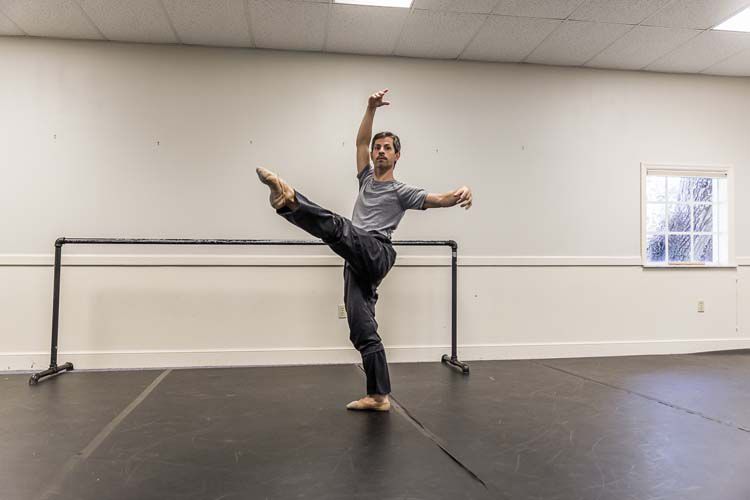
From the first toddler who straddled a stick and galloped around a campfire, man has imitated horse. This weekend, the Vero Beach Museum of Art provides some stunning examples, not only in its new exhibition of Deborah Butterfield’s horse sculptures, but in a collaboration Friday night with Ballet Vero Beach.
Tasked with creating a work using Butterfield’s horses as inspiration, Camilo Rodriguez, the young company’s ballet master and star dancer, has created one of his most beautiful ballets to date. At least that was the opinion of this viewer, who saw a rehearsal last week; Rodriguez himself hinted that he may agree. As the 10-minute run-through came to a close, leaving his audience of one awestruck, he placed his hands to his heart and quietly sighed, “I cherish it.”
“An Afternoon in the Paddock,” as Rodriguez calls his dance set to Debussy’s “The Afternoon of a Faun,” is another in a series of performances at the museum featuring choreography inspired by the art on exhibit. This time, there are six dances – two interpretations for each of three exhibits. He is one of seven choreographers who created the works – all premieres – and one of three dancers performing them.
Each of those dances represents many hours – weeks, even – of creative work, to say nothing of rehearsal time. For Rodriguez, who both choreographed the piece and dances in it, that work began on the Internet, downloading images of Butterfield horses and listening to lectures she has given about her art.
“From early in her career, she was interested in the mare,” says Rodriguez. “She saw a sort of serene vulnerability in a horse lying down. We always think of horses for battle or work, often as heroic. She was looking for something different from that concept. She saw a self-portrait in the work that she was doing. I was looking for something pensive, a kind of wisdom, a vulnerability.”
He also gave thought to the materials she used in her sculpture, the “palettes of materials that she started seeing these shapes in.” His “palette” included the confines of the stage at the museum’s Leonhardt auditorium; the space became his “paddock,” and he makes his entrance through a side door like a horse bolting of the barn.
Not every movement is that literal. Most of the dance alludes to the emotions and attitudes of the horse, and the emotions and attitudes humans attribute to them. “We think they’re feeling a certain way, but we don’t know,” says Rodriguez. “We assume things from the visual.”
In addition to taking in Butterfield’s own musings, for three days, almost endlessly, he watched videos of horses, absorbing the “psychological and internal energy of the horse,” much as he perceived Butterfield does.
“I watched wild horses, domesticated horses, horses running, jumping, doing dressage and just in nature. Then I would come to the studio and subconsciously all that I had seen would come out.”
Details as telling as how a horse sleeps – standing, but with its head lowered to the ground – stayed with him as he composed his movements. In his dance, that “non-trusting” posture told of an animal always prepared to flee.
Unlike other choreographers, Rodriguez typically doesn’t see his dance in full prior to putting it to paper. Instead, he would improvise in the studio, letting information and inspiration “wash my brain.” With Debussy’s score playing, the shapes, steps and moods evolved over hours and days. “I did five different drafts of this and ended up scratching them all,” he says. “That’s how I work.”
At point, he considered doing the dance as a man but on pointe; that was scrapped, though he is leaving it a surprise as to what he will wear. In the original 1912 ballet to the same music, the great male dancer Nijinsky wore spots painted on his chest and arms and printed on a tunic. Woven into his wig were tiny horns – the mythical faun in the title is half-man, half-goat. Nijinsky’s role was later dance by Rudolf Nureyev and is now part of the repertory of the Joffrey Ballet, among others.
“At first I thought the music was too specific,” says Rodriguez. “Then I just let the process take over.”
The result is a solo of mostly classical movements, often suggestive of the movements of a horse, as when he rolls on his back on the floor. But just as often he plays with the horse as a concept – he lies with an arch in his back and rocks at one point: a rocking horse. At another point, he passes his bent arms alongside his face, creating the silhouette of a horse’s angled head. And there is one scene in which he mimes blowing a horn – a suggestion of the hunt, Rodriguez says, but also a reference to Nijinsky’s faun, who picks up a flute and plays.
As of late last week, Rodriguez had yet to see the Butterfield works in person, apart from the two in the collection of the museum – one in the Beckwith Sculpture Garden and another in the Stark Rotunda. Nevertheless, he understands them in a way others might not – Rodriguez himself studied sculpture before devoting himself to dance as a student at a full-time arts academy in Puerto Rico, where he was raised.
“We sculpt, but slowly,” he says of dancers. “The more you repeat a movement the more the muscle is going to change by the force of gravity and in our effort not to fall. And with students, you’re teaching them how to stand, how to move.”
Like Butterfield stilling her horses in sculpture, choreographers are creating shapes with dancers.
“She knows what that kinetic energy feels like,” says Rodriguez. “As dancers, we totally get that.”



